Traveling Down the Amazon River
A Pictorial Essay from the Andes to the Atlantic Ocean
Article and photos by Volker Poelzl
The Amazon is a vast ecosystem, stretching from the eastern slopes of the Andean mountains in Ecuador, Peru, and Bolivia to the Atlantic Ocean. It is the world's most extensive river system with the world's largest rainforest and most extraordinary biodiversity. But these superlatives cannot aptly describe the region's immense ecological and cultural diversity. When I set out from the Peruvian city of Cuzco to travel by train along the Urubamba River and then continue downriver by boat towards the Amazon, I had no idea how vast and incomprehensible this region would be. My journey was at once magical and tedious, dangerous and mesmerizing. On my way to the Amazon, I passed through dangerous rapids and narrow gorges, stayed at hospitable indigenous communities, and was welcomed by settlers to spend the night in their palm-thatched huts. I passed towering cliffs with clay licks where dozens of colorful macaws gathered to lick vital nutrients, watched monkeys climb through the dense foliage along the banks, and observed river dolphins playing alongside the boats upon which I was traveling.
 |
| The Urubamba river, one of the major tributaries of the Amazon, originates near Cuzco, Peru. From there, it drains the Sacred Valley, home to many Inca ruins, and flows below Machu Picchu before descending into the Amazon basin. Above is a view of the Sacred Valley and the narrow Urubamba River. |
 |
| The Amazon rainforest stretches from the eastern slopes of the Andes to the Atlantic Ocean. Machu Picchu is surrounded by a spectacular cloud forest, which gradually gives way to the majestic Amazon rainforest at lower elevations. |
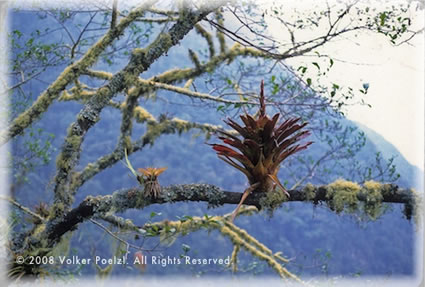 |
| The cloud forest gets much moisture from low-hanging clouds, hence its name. Due to the high humidity, epiphytes and other plants with air roots are commonly found on trees. |
 |
| Settlements throughout the sparsely populated Amazon are often located at road junctions or where waterways meet roads. At this small hamlet, Kiteni, the water level of the Urubamba River was too low for boat traffic, so I had to travel another day through the jungle in the bed of a large pick-up loaded with drums of diesel fuel. |
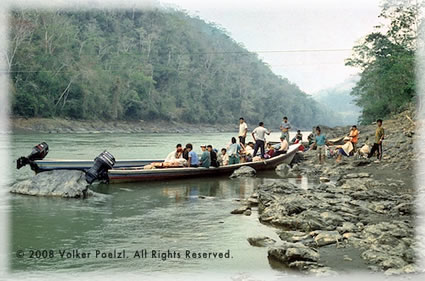 |
| Finding a passenger boat on the Urubamba takes a lot of patience. When I embarked on this boat, I had only arrived the previous night. Still, further down the river, I spent several days at native villages waiting for another boat. |
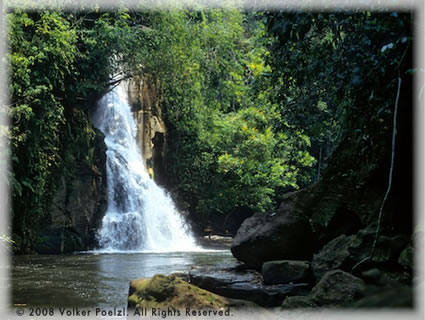 |
| All water from the Adeans glaciers, snow runoff, and rain flows toward the Amazon River, cascading into the Amazon basin in massive waterfalls and gushing rivers. The force of the water has carved massive gorges and canyons into the rock, often making navigation very difficult and dangerous. |
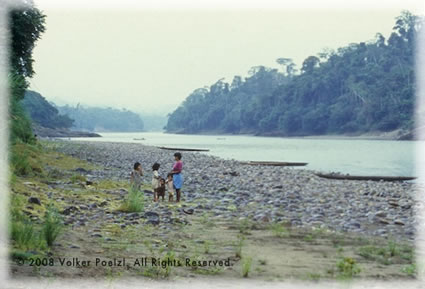 |
| The Machiguenga Indians live in small settlements in a remote region along the lower Urubamba River. However, recent natural gas exploration is not only threatening the local environment but also the traditional culture of the native people. |
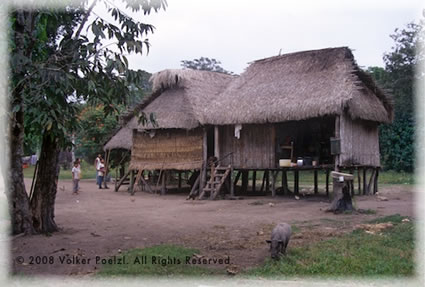 |
| The upper reaches of the Amazon are challenging to reach by road or river. Still, as soon as I reached the lower elevations of the Amazon basin, boat traffic became more common. Small homesteads and settlements lined the river banks of the Urubamba River. |
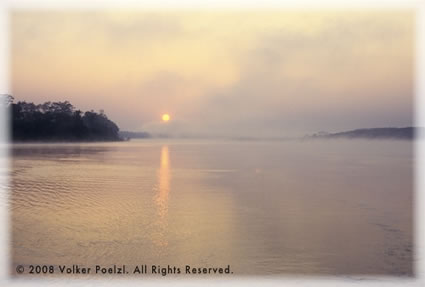 |
| When the Urubamba River joins the Apurimac River, it becomes the Ucayali River, the Amazon River after its confluence with the Rio Marañon. While the Urubamba is narrow all along its course, with the jungle and wildlife never far away, the Ucayali quickly becomes nearly a mile wide, even though still thousands of miles away from the Atlantic Ocean. |
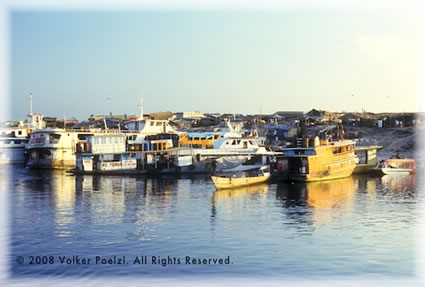 |
Pucallpa is an unattractive frontier town but an important trading hub since it is only one of two cities in the Peruvian Amazon with road access to the rest of Peru. Situated near the banks of the Ucayali River, Pucallpa has regular boat traffic to the Peruvian city of Iquitos further downstream. |
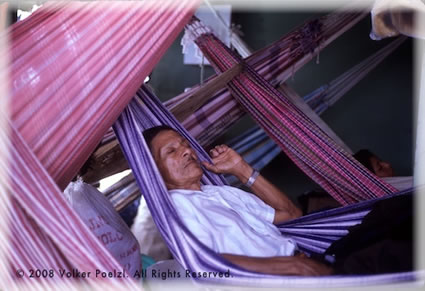 |
| Life on a riverboat is more tedious than it is romantic, and an afternoon nap is often the passengers' only escape from the never-ending monotony of watching the distant forest-lined shores pass by day after day. |
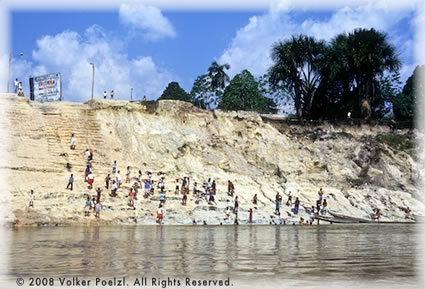 |
| The Amazon's and its tributaries' water levels vary enormously between the rainy and dry seasons, as is evident at this Peruvian village on the Rio Ucayali, where at the height of the dry season, the river flows about fifty feet below its high-water level. |
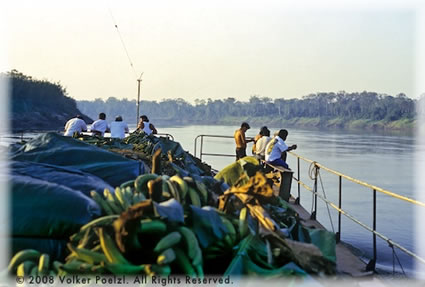 |
| Passenger boats in Peru are little more than barges, where there is often very little room for passengers. Here, a shipment of bananas completely takes up the upper deck. |
|
Most people along the Amazon River depend exclusively on the river for their livelihoods. The Brazilian author Leandro de Tocantins aptly named one of his books "The River Commands Life," showing how interdependent the locals' lives are with the annual rise and fall of the waters. |
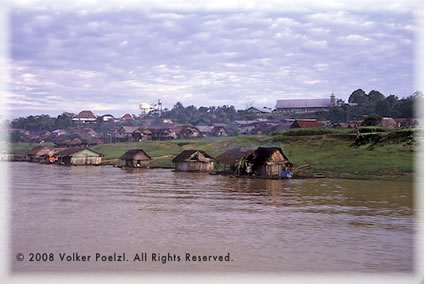 |
| Traveling down the Amazon provides a great history lesson, not only about South America's Inca civilization and the cultures of the native people but also about recent history. The small town of San Pablo, located along the Amazon River in Peru, was where Ernesto Che Guevarra volunteered at a leprosy colony during his South America trip in 1951. |
 |
| One of the main staple crops in the Amazon is Manioc (or cassava). Harvesting and processing the manioc roots is a communal effort, and the extended family usually lends a hand. |
|
| The Amazon rainforest is a complex ecosystem where all plants compete for light. Vegetation extends from the dark forest floor to the upper canopy, where vines dangle down from great heights and epiphytes, mosses, and lichens grow on every branch. |
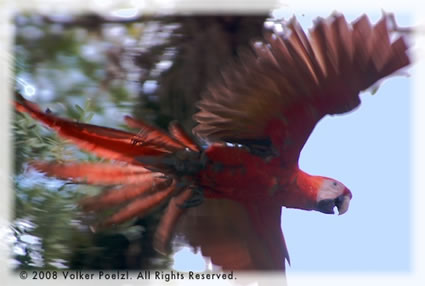 |
| Scarlet Macaws are among the most colorful and majestic birds in the Amazon. They eat fruits and seeds and prefer to roost in the upper canopy of the rainforest, making them difficult to spot from the ground. |
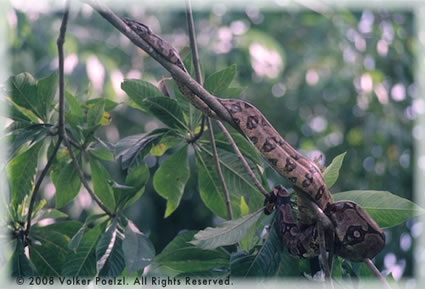 |
| The Amazon is home to a fantastic diversity of animal and plant life. The tree boa is only one of many snake species that inhabit the dense rain forest. |
 |
| Manaus is the largest city and most significant port in the Amazon, located over 900 miles upriver from the Atlantic Ocean. In addition to hundreds of passenger boats that leave every day, ocean-going vessels can also reach Manaus. |
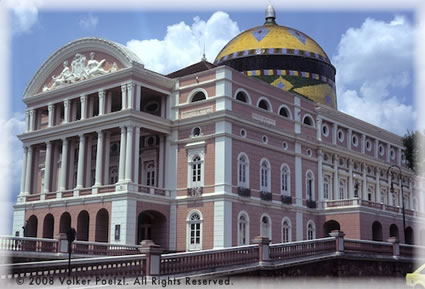 |
| The Amazonas Theater in Manaus is the region's most impressive architectural monument. It was built during the rubber boom in the late 19th century. Rubber barons amassed enormous wealth, and the city is still home to historic buildings imported entirely from Europe. |
 |
| The main branch of the Amazon is muddy and reddish. Wherever a river of different colors enters it, the waters create a spectacular "meeting of the waters," where differently colored currents run side by side for miles before finally blending together. |
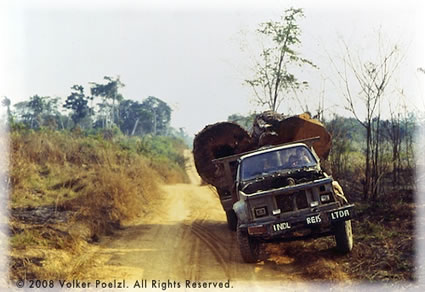 |
| Wherever there are roads in the Amazon, there is also a lot of deforestation. Tropical hardwood species, such as these substantial mahogany logs, have become quite rare as legal and illegal logging has advanced into remote areas of the rainforest in search of precious timber. |
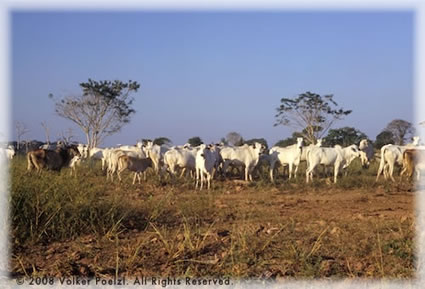 |
| Roads and deforestation are quickly followed by cattle pastures. Today, vast ranches cover much of the Amazon in Brazil, once covered by dense rainforests. |
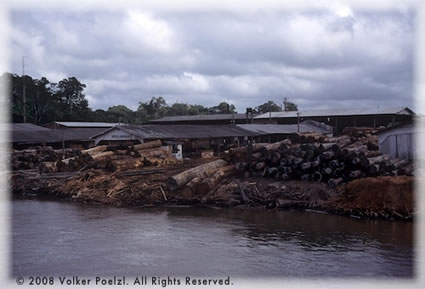 |
| Where roads are absent, sawmills are strategically located along navigable rivers, where precious logs can easily be transported by boat. |
|
| Many locals along the Amazon live in small settlements, often far from the nearest town. They depend largely on dugout canoes to sell their produce or fish in town and even to paddle to school. |
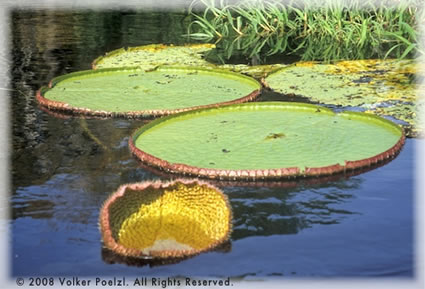 |
| The victoria amazonica, a water lily with large flat leaves, is the emblematic flower of the Brazilian Amazon. It is home to the 'várzea', low-lying forest that is annually flooded by the rising waters of the Amazon. |
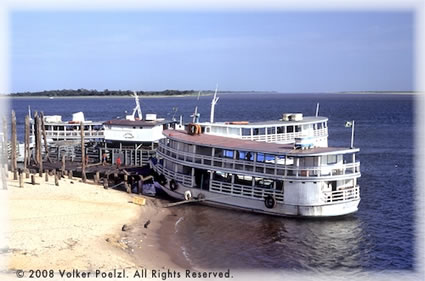 |
| The city of Santarém, located halfway between Manaus and the Atlantic Ocean, is located at the mouth of the Tapajós River, which empties its deep blue water into the muddy Amazon. |
 |
| Fishing is an essential industry in the Amazon and a vital food supply for the local population. However, overfishing is threatening some fish species, especially near large urban centers. The fish caught here are Tambaqui (also known as Pacu), a large fish that lives off seeds and fruits. |
 |
| On its lower course, the Amazon River is up to 7 miles wide, and sudden microbursts can whip up waves that toss around the boats and make passengers feel like they are on an ocean voyage. |
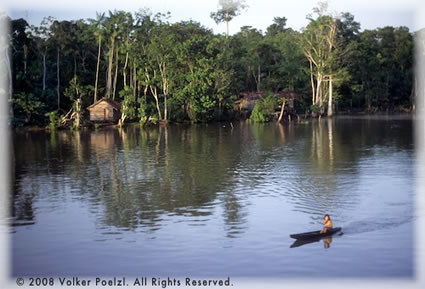 |
| Before reaching the Atlantic Ocean, the Amazon River splits into dozens of channels, forming hundreds of islands. Since the low-lying land is often flooded year-round, the trees are noticeably smaller, with many water-tolerant species. |
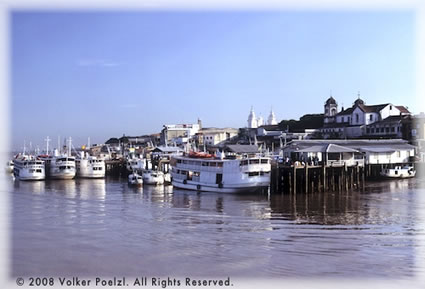 |
| The city of Belém is located at the southernmost branch of the vast Amazon estuary, not far from the Atlantic ocean. My long journey down the Amazon from the Andes to the sea finally ended here. |
Volker Poelzl is a Living Abroad Contributing Editor for TransitionsAbroad.com. He has extensively traveled in the Amazon, and among his most memorable trips was this long journey from the Andes to the Atlantic Ocean.
|
